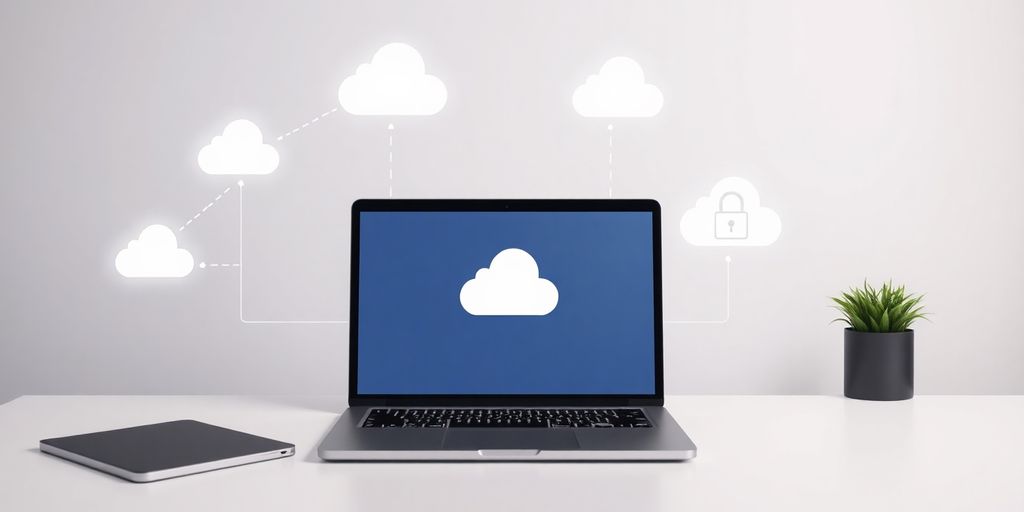In 2025, the digital landscape is more connected than ever, and cloud sharing is at the heart of it all. But with great connectivity comes the need for robust security measures. Whether you’re sharing files for work or personal use, keeping your data safe is a top priority. This guide will walk you through the essentials of secure cloud sharing, helping you make informed choices and integrate these practices into your daily routine.
Key Takeaways
- Security in cloud sharing is more important than ever in 2025, requiring strong measures to protect data.
- Choosing the right cloud service involves comparing options like Google Drive, Dropbox, and OneDrive to suit your needs.
- Best practices like encryption, two-factor authentication, and regular audits are essential for secure cloud sharing.
Unlocking the Secrets of Secure Cloud Sharing

Why Security Matters More Than Ever
Alright, let’s get real for a moment. In 2025, the digital world is practically bursting at the seams with data. It’s like a never-ending buffet, and everyone wants a piece. But here’s the kicker: not everyone should get a taste. Security is your bouncer, keeping the riff-raff out and making sure only the invited guests get in. With data breaches making headlines more often than celebrity breakups, keeping your cloud sharing secure isn’t just a nice-to-have—it’s a must.
The Evolution of Cloud Sharing: A Brief History
Once upon a time, cloud sharing was the new kid on the block, promising to revolutionize how we store and share data. Fast forward to today, and it’s like the smartphone of data storage—ubiquitous and indispensable. We’ve gone from floppy disks and USB drives to a world where your files float in the ether, accessible from anywhere with a Wi-Fi signal. It’s wild how far we’ve come, and the journey’s been all about making things faster, easier, and yes, more secure.
Common Pitfalls and How to Avoid Them
Now, let’s talk about the potholes on the road to cloud nirvana. First up, there’s the classic "I forgot my password" conundrum. It’s like locking yourself out of your own house. Then, there’s the "oops, I shared the wrong file" moment—awkward! And let’s not even get started on ignoring those pesky software updates. To keep your cloud sharing game strong, remember these golden rules:
- Use strong, unique passwords and keep them safe.
- Double-check your sharing settings before hitting send.
- Keep your software up-to-date to fend off unwanted guests.
In the end, mastering secure cloud sharing is a bit like learning to ride a bike. It might be wobbly at first, but once you get the hang of it, you’re cruising. And trust me, the peace of mind is totally worth it.
Choosing the Right Cloud Service for Your Needs
Comparing the Big Players: Google Drive, Dropbox, and OneDrive
Alright, let’s talk cloud storage. It’s like picking a favorite ice cream flavor—everyone’s got their own preference, and there’s no wrong choice. But when it comes to the big three—Google Drive, Dropbox, and OneDrive—each has its own charm.
- Google Drive: It’s the popular kid in school, known for its seamless integration with other Google services. If you’re already living in the Google ecosystem, this one’s a no-brainer.
- Dropbox: Think of it as the reliable friend who’s always got your back. It’s simple, effective, and works well across different platforms.
- OneDrive: The office go-getter, perfect if you’re a Microsoft Office enthusiast. It plays nicely with all things Windows.
Here’s a quick comparison to help you out:
| Feature | Google Drive | Dropbox | OneDrive |
|---|---|---|---|
| Free Storage | 15 GB | 2 GB | 5 GB |
| Integration | Google Apps | Various | Microsoft |
| Best For | Collaboration | Simplicity | Office Users |
How to Evaluate Security Features
Now, onto security—because nobody wants their files floating around the internet like a lost balloon. When weighing your options, keep an eye out for these security features:
- Encryption: Make sure your data is encrypted both in transit and at rest.
- Two-Factor Authentication: Adds an extra layer of protection, because one password just isn’t enough these days.
- Regular Security Audits: Check if the provider undergoes regular security checks to keep everything spick and span.
Remember, choosing the right cloud service is like picking a digital vault. You want it to be as secure as Fort Knox.
Customizing Your Cloud Experience
Finally, let’s talk customization. Your cloud storage should fit like a glove, not a one-size-fits-all poncho. Here are some ways to make it your own:
- Storage Allocation: Decide how much space you need and adjust as you go. No point in paying for storage you won’t use.
- Integration Options: Look for a service that blends well with the tools you already use. Whether it’s syncing with your email or connecting with your favorite apps, make sure it fits your workflow.
- User Management: If you’re sharing with a team, ensure you can easily manage who sees what. Nobody wants their grandma accidentally accessing the company financials.
Choosing a cloud service isn’t just about storage—it’s about finding a partner that keeps your data safe and sound, while making your digital life a little easier. Explore how digital document storage can transform your workflow.
Best Practices for Secure Cloud Sharing
Encryption: Your Best Friend in the Cloud
Alright, let’s talk about encryption. Imagine it as your digital bodyguard, keeping all your precious files safe from prying eyes. Encryption is like wrapping your data in a secret code that only you and your intended recipient can understand. When you’re dealing with cloud storage, make sure your provider uses strong encryption both when your files are being sent and when they’re just chilling in the cloud. It’s like having a double lock on your front door. And hey, don’t forget to encrypt files before they even leave your device. It’s like putting on sunscreen before you hit the beach.
Two-Factor Authentication: Double the Security, Double the Fun
Password alone? Nah, that’s so 2020. In 2025, we’re all about two-factor authentication (2FA). Think of it as having a bouncer at the club entrance. You need more than just a password to get in; you need something else, like a code sent to your phone. This extra step can seriously beef up your security game and keep those pesky hackers at bay. Plus, it’s a great way to impress your friends with your top-notch security skills. So, next time you’re setting up an account, make sure to enable 2FA. Your future self will thank you.
Regular Audits: Keeping Your Data Safe and Sound
Now, let’s chat about audits. Not the boring tax kind, but the kind that keeps your data safe. Regular security audits are like having a health check-up for your cloud storage. They help you spot any weaknesses in your setup and fix them before they become a problem. Schedule these audits periodically and make it a habit. It’s like brushing your teeth; you don’t just do it once and call it a day. Keeping your data secure is an ongoing process, and regular audits are a key part of that. Remember, a little prevention goes a long way in keeping your data safe and sound.
"In the wild world of cloud sharing, being proactive about security is your best bet. It’s not just about having the right tools, but also about using them wisely and consistently."
Integrating Secure Cloud Sharing into Your Workflow

Seamless Integration with Existing Tools
Integrating cloud storage into your daily grind doesn’t have to be a head-scratcher. Whether you’re a Google Drive devotee or a Dropbox die-hard, these platforms play nice with most of the tools you already use. Imagine your cloud storage as the ultimate sidekick, always ready to swoop in and save the day by syncing with your favorite apps. No more fumbling around for files—everything’s right where you need it.
Automating Your Cloud Processes
Let’s face it, manually uploading and organizing files is so last decade. Automation is your new best friend. Set up automatic backups and scheduled uploads so you can focus on the fun stuff, like brainstorming your next big idea. With automation, your data is always up-to-date, and you don’t have to lift a finger. Here’s how you can get started:
- Choose a cloud service with automation features.
- Set up rules for automatic file uploads.
- Schedule regular backups to keep your data safe.
Training Your Team for Success
A tool is only as good as the person using it. Get your team up to speed with a little training. Show them the ropes, and soon they’ll be cloud-sharing pros. Trust me, a bit of upfront training can save you from future headaches. You might even find some hidden tech talents among your crew! Encourage questions and foster a culture where learning and adapting are part of the daily routine.
"Integrating cloud sharing into your workflow isn’t just about technology; it’s about making life easier for you and your team. Embrace the change, and watch your productivity soar."
For more tips on mastering cloud security, check out these essential steps for keeping your data safe.
Wrapping It Up: The Future of Cloud Sharing
So, there you have it, folks! As we look ahead to 2025, it’s clear that secure cloud sharing isn’t just a tech trend—it’s a necessity. Whether you’re a business trying to keep your financial statements in check or just someone who wants to make sure your vacation photos are safe from prying eyes, the cloud’s got your back. With tools like StatementCloud making it easier than ever to manage your documents, you can finally say goodbye to the days of lost files and manual downloads. Just remember, while the cloud is a fantastic tool, it’s still important to stay savvy about security. Keep those passwords strong and your two-factor authentication on, and you’ll be sharing like a pro in no time. Until next time, happy sharing!
Frequently Asked Questions
What is secure cloud sharing?
Secure cloud sharing means safely storing and sharing files over the internet using cloud services. It involves using strong passwords, encryption, and other security features to keep your data safe from hackers.
How do I choose the best cloud service for my needs?
To pick the best cloud service, think about what you need, like storage space, cost, and security features. Compare big names like Google Drive, Dropbox, and OneDrive to see which one fits you best.
Why is two-factor authentication important?
Two-factor authentication adds an extra layer of security by requiring two forms of verification before you can access your account. This makes it harder for bad guys to break in and keeps your information safer.







